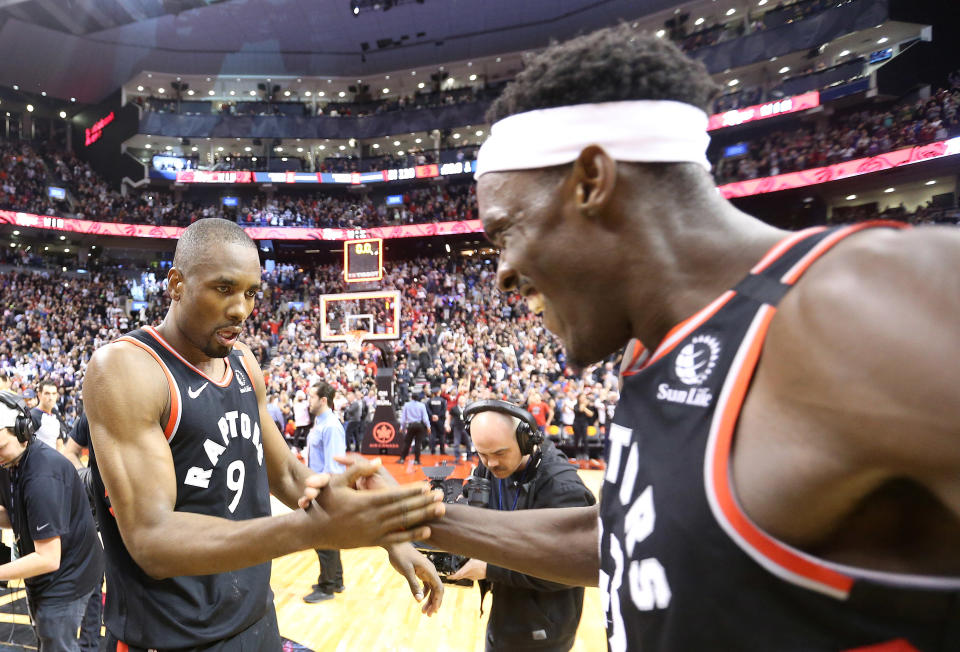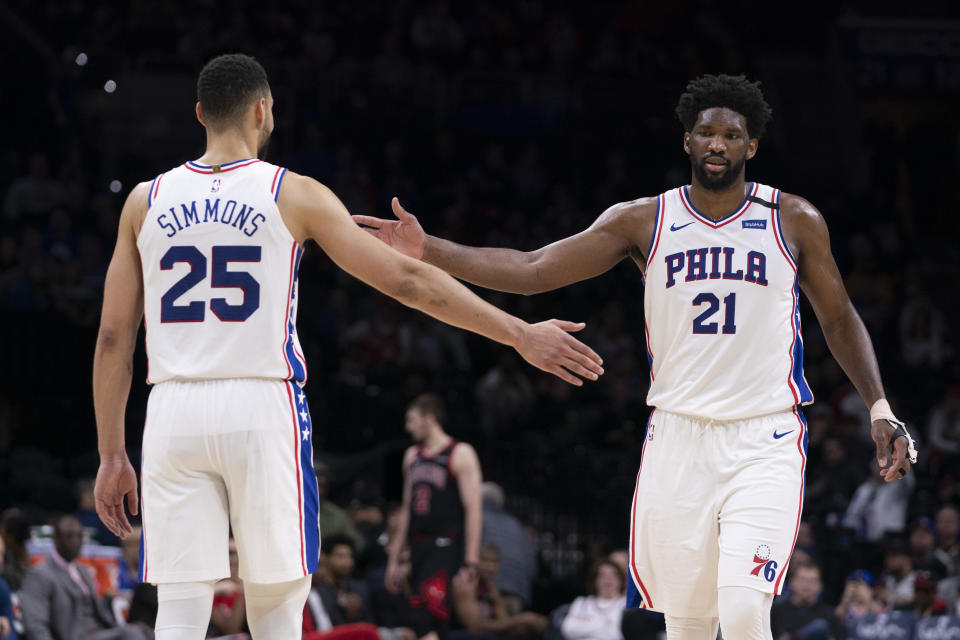Can anyone in the East upset Giannis Antetokounmpo's Bucks?
For better or worse, the NBA is forging ahead with its plan to restart the 2019-20 season at the end of the month in Orlando, Florida. Over the next two weeks, as teams report to Walt Disney World for training camp, we will dive deep into the big-picture basketball questions left to be answered between now and October.
[A brief history of where the NBA left off and what it means for an impending return]
The Milwaukee Bucks have been incredibly efficient in the halfcourt, both offensively and defensively, largely because Giannis Antetokounmpo is the NBA’s most potent weapon on either end of the floor. Protecting the rim at all costs, they also turn rebounds into transition scoring opportunities at a more effective rate than anyone. The result was a historically great net rating before the league went on hiatus.
All that is left for the Bucks to prove is translating that success to the playoffs, where they were rolled by the Toronto Raptors in the final four games of the Eastern Conference finals last season after a pair of first-round exits the two previous years. Antetokounmpo returned from his 2019 MVP campaign a better player, the Bucks better executed coach Mike Budenholzer’s system in their second season together, and Milwaukee is undoubtedly favored to emerge from the East, regardless of any lingering questions.
[Create or join a 2020 Yahoo Fantasy Football League for free today]
But the conference is deeper with high-end teams than any other year in recent memory, currently boasting six teams with a .600 winning percentage or better for the first time since the Michael Jordan era. The Raptors, Boston Celtics, Miami Heat, Indiana Pacers and Philadelphia 76ers were all on pace to win 50-plus games before COVID-19 halted the season. The Pacers are probably in greatest danger of falling off that pace over the final eight regular-season games in Orlando, having lost Jeremy Lamb to a knee injury before recently returned All-Star guard Victor Oladipo opted out of the restart last week.
The game plan for upsetting the Bucks is fairly straightforward, even if executing it is obviously far more difficult. The biggest key is having multiple defenders to rotate onto Antetokounmpo, all while building a brick wall at the rim behind the frontline. The Celtics unleashed this strategy against a pre-MVP Giannis in a 2018 first-round playoff victory, and the Raptors overcame him with a similar approach last season.
Outside of slowing (not stopping) Antetokounmpo, challengers must chip away at the 10.7 points per 100 possessions that separated Milwaukee from its opponents this season. Slow the Bucks’ transition from live rebounds. Cover and recover, running shooters off the arc, where almost a third of their shots are attempted, and protecting the rim, where Giannis is a destroyer. Push the pace offensively on forced turnovers defensively, two of Milwaukee’s middling areas. Get to the free-throw line. Most importantly, make threes and generate second-chance opportunities, arguably the Bucks’ two chief vulnerabilities.
Despite the roster overhaul in Boston and Leonard’s departure from Toronto, both teams are likely still best equipped to challenge Milwaukee because they have the personnel to best tighten those gaps. In our closer look, we will throw Philadelphia and Miami into the mix as well, because both have a ton of options to throw at Antetokounmpo. (If only Indiana had Oladipo to offset its vast offensive differential.)
(Statistics via Cleaning the Glass and Second Spectrum.)

Toronto Raptors (46-18)
vs. Milwaukee: 0-2
Of the four challengers, the Raptors are the only team to have not won a game against the Bucks. Antetokounmpo unleashed vengeance in the sixth game of the season, posting a 36-15-8 with four blocks in a 115-105 win against the team that eliminated him from last season’s conference finals. Even without Marc Gasol in the middle for their late February meeting, Toronto did a better job of slowing Antetokounmpo (19 points on 5-for-14 shooting), but the result was just the same, a 108-97 Bucks win.
Half-court defense: 1st (88.5 points per play allowed)
Transition defense: 12th off live rebounds (0.9 PPP added); 8th off steals (1.3 PPP added)
3-point defense: 1st in accuracy (34.3 3P%); 29th in frequency (40.5%)
Rim protection: 3rd in accuracy (59.3%); 7th in frequency (33.2%)
Defensive turnover rate: 2nd (16.8%)
Even without Leonard, the Raptors have long-armed disruptors in Pascal Siakam and OG Anunoby to throw at Antetokounmpo on the perimeter. Behind them are Gasol and Serge Ibaka, a pair of high-level and high-IQ post defenders who acquit themselves well on switches and protect the rim with aplomb.
Their collective length and athleticism helps them defend in transition and contest 3-pointers, even as their rim-protecting scheme might allow more long-distance attempts from Khris Middleton and Milwaukee’s many wing shooters — signs of a solid modern defense you will find common in this space.
Kyle Lowry and Fred VanVleet are both among the league’s more underrated guard defenders, and they should make life difficult for the Bucks’ secondary ball-handlers. Eric Bledsoe, whose playoff problems are well documented, could be in for more trouble if the point guard’s turnover woes keep plaguing him.
The only outfit better suited to defend the Bucks than this year’s Raptors is probably the version that stopped Antetokounmpo and company last year, only with Leonard’s brilliance filling Anunoby’s shoes.
Half-court offense: 18th (94.8 points per play)
Transition offense: 2nd off live rebounds (2.1 PPP added); 1st off steals (2.1 PPP added)
3-point offense: 8th in accuracy (37.2%); 5th in frequency (38.6%)
Offensive rebound rate: 24th (24.2%)
Free-throw rate: 12th (20.5%)
Siakam’s emergence as an offensive fulcrum also helped the Raptors withstand the loss of Leonard offensively. Two of Toronto’s greatest strengths — turning steals into points and 3-point shooting — counter Milwaukee’s greatest weaknesses. And you can imagine the Raptors’ length, along with their backcourt’s craftiness, could also generate more second chances and free throws with increased focus.
With Ibaka and Gasol both capable of stepping out to the perimeter (a combined 40 percent on 6.8 3-point attempts per game), coach Nick Nurse can field all sorts of five-out shooting lineups. Lowry, VanVleet and Siakam have made Toronto especially dangerous on non-corner threes, where Milwaukee is weakest. (Remember, too, that increased 3-pointers improve offensive rebounding opportunities.)
You could talk yourself into Toronto as Milwaukee’s perfect foil, if the Raptors were not winless against the Bucks already. They are scheduled to play each other once more in the regular season on Aug. 10.

Boston Celtics (43-21)
vs. Milwaukee: 1-1
All-Star point guard Kemba Walker went off for 32 points, six rebounds and six assists to lead an otherwise balanced effort against Antetokounmpo (22-14-5 on 13 shots) and the Bucks in a 116-105 win in the fourth game of the season. Walker scored 40 in their mid-January meeting, but Antetokounmpo (32-17-7 on 22 shots) was an absolute monster in a tightly contested 128-123 mid-January win over a Boston team without Jaylen Brown. As always, Celtics killer Khris Middleton was great in both games.
Half-court defense: 4th (91.8 points per play allowed)
Transition defense: 4th off live rebounds (0.5 PPP added); 3rd off steals (0.9 PPP added)
3-point defense: 6th in accuracy (34.8%); 24th in frequency (36.4%)
Rim protection: 12th in accuracy (62.5%); 6th in frequency (33.0%)
Defensive turnover rate: 4th (15.6%)
The Celtics no longer have Al Horford and Aron Baynes, who respectively and effectively played the defensive roles of Serge Ibaka and Marc Gasol in slowing Antetokounmpo during their first-round series in 2018. And the Bucks destroyed Boston in their second-round series last year, making a turnstile out of Kyrie Irving.
But the Celtics are a vastly improved defensive team from the one that flamed out a year ago, primarily because Jayson Tatum and Jaylen Brown have improved as high-level wing defenders every season. Marcus Smart is arguably the league’s best perimeter defender, strong enough to make up for what he concedes to Antetokounmpo in size. Throw in brute defensive specialist Semi Ojeleye, who coach Brad Stevens deployed opposite Antetokounmpo in 2018, and Boston has the bodies to throw at Giannis.
Even with Enes Kanter serving as the backup center, the Celtics have pieced together solid rim protection, again thanks to the ball-swarming abilities of Tatum, Brown and Smart. Starting center Daniel Theis has also improved in that regard, and uber-athletic second-year big Robert Williams is an intriguing option, so long as he rehabbed from the injury that cost him half the season and he’s developed his game.
They may not have the experience together that the Raptors do, but the Celtics have the weapons, many of whom know from experience both how to beat Antetokounmpo’s Bucks and how daunting a task it is.
Half-court offense: 11th (96.6 points per play)
Transition offense: 20th off live rebounds (0.8 PPP added); 6th off steals (1.8 PPP added)
3-point offense: 12th in accuracy (36.8%); 14th in frequency (35.4%)
Offensive rebound rate: 8th (27.1%)
Free-throw rate: 11th (20.6%)
Almost as soon as Tatum was voted into his first All-Star Game, he exploded as a superstar-level scorer. From the start of February to the mid-March hiatus, Tatum averaged 29.2 points on 48/47/75 shooting splits, a stretch seemingly unsustainable if not for his arsenal of offensive weaponry. How that meshes with the presumably healthy return of Kemba Walker (knee) will determine Boston’s offensive ceiling.
Regardless of where the Celtics fall in terms of 3-point efficacy, their top five 3-point shooters — Walker, Tatum, Smart, Brown and Gordon Hayward — are shooting a combined 38 percent on 26.5 tries per game, and they will be doing the bulk of the work from distance in the playoffs. Everyone in the rotation, save for Kanter, is capable of catching fire from deep, and that could be an issue for the Bucks.
Kanter is capable of making up for his defensive lapses by creating second chances on the glass. That, along with a renewed focus by Boston’s many playmakers to attack the rim and draw fouls, could help close an offensive gap between the two teams that expanded into a chasm in the playoffs last season.

Miami Heat (41-24)
vs. Milwaukee: 2-0
Goran Dragic’s 25 points off the bench helped the Jimmy Butler-less Heat beat the Bucks in overtime despite 54 combined points from Antetokounmpo and Middleton in the second game of the season, a testament to Miami’s depth. With Butler, the Heat stomped Milwaukee in March, holding Giannis to 13 points on 18 shots and the Bucks to 89 points as a team. This was also after Miami added Jae Crowder and Andre Iguodala at the trade deadline, bolstering their defensive options against Antetokounmpo.
Half-court defense: 15th (94.3 points per possession allowed)
Transition defense: 1st off live rebounds (0.4 PPP added); 26th off steals (1.9 PPP added)
3-point defense: 4th in accuracy (34.7%); 30th in frequency (40.5%)
Rim protection: 25th in accuracy (65.7%); 5th in frequency (32.4%)
Defensive turnover rate: 23rd (13.7%)
Like the Raptors and Celtics, the Heat have the athletes to cover a lot of ground. Test Bam Adebayo anywhere on the floor at your peril. Miami is just fine funneling playmakers into his space. Few players outwork the Heat’s center on defense, and Butler may be one of them. The sample size since adding Crowder and Iguodala is not large enough to make any determination, but collectively they at least give Miami a fighter’s chance against both Antetokounmpo and the shooters for whom he creates space.
Half-court offense: 4th (99.1 points per possession)
Transition offense: 15th off live rebounds (1.0 PPP added); 16th off steals (1.5 PPP added)
3-point offense: 1st in accuracy (39.1%); 8th in frequency (37.7%)
Offensive rebound rate: 25th (24.0%)
Free-throw rate: 3rd (23.3%)
At what cost does coach Erik Spoelstra throw his newly added wings into the mix. Despite boasting Butler and Adebayo, a pair of All-Stars who do not shoot from distance, the Heat have been one of the league’s best 3-point shooting teams, thanks to flame-throwing from Duncan Robinson and Tyler Herro. While Crowder and Iguodala are both capable, neither are reliable knockdown shooters.
Spoelstra has been creative in creating offense during the regular season, but beyond Butler and Dragic, Miami lacks the kind of proven shot creators who extinguish offensive lapses in the playoffs. The Heat could find themselves walking a tightrope as they try to strike a balance between offense and defense.

Philadelphia 76ers (39-26)
vs. Milwaukee: 1-2
Joel Embiid led Philadelphia’s star-studded starting lineup in a statement win on Christmas Day, scoring 31 points in a 121-109 victory. Ben Simmons and a ridiculously lengthy 76ers defense held Giannis to 18 points on an abysmal 8-for-27 shooting performance (0-for-7 from three). Philadelphia’s chemistry cracks showed in their two February meetings, as Antetokounmpo combined for 67 points, 37 rebounds and 14 assists in a pair of lopsided victories. The already shallow Sixers were missing Josh Richardson in the second of those meetings, and by the third game coach Brett Brown had moved Horford to the bench.
Half-court defense: 13th (94.2 points per play allowed)
Transition defense: 5th off live rebounds (0.6 PPP added); 15th off steals (1.5 PPP added)
3-point defense: 14th in accuracy (35.8%); 1st in frequency (31.2%)
Rim protection: 19th in accuracy (64.3%); 18th in frequency (36.0%)
Defensive turnover rate: 17th (14.2%)
It is almost inconceivable that the Sixers are a middling 3-point defense and porous rim-protecting team, but All-Stars Embiid and Simmons both missed significant time during the regular season, and Horford has lost a step since he led the Celtics to two straight conference finals. With their combined length and athleticism, they may still be the best trio any team can field against Antetokounmpo. Throw in Matisse Thybulle, already one of the league’s best perimeter defenders, and they are well-equipped.
Embiid, in particular, can be the best defender in the league when healthy and engaged. Assuming he is both in Orlando, the Sixers could well shed their fit issues and look like the team that won Christmas.
The presumed starting lineup of Simmons, Embiid, Richardson, Horford and Tobias Harris is allowing 97.5 points per 100 possessions, four points better than Milwaukee’s league-leading defensive outfit. Brown will ride them for all they are worth (which is a lot!), but beyond them he falls into trouble. Thybulle creates offensive floor-spacing issues, and the midseason additions of Alec Burks and Glenn Robinson III to a bench that primarily featured Furkan Korkmaz is not striking fear into any opponent’s offense.
Half-court offense: 13th (95.8 points per play)
Transition offense: 24th off live rebounds (0.5 PPP added); 14th off steals (1.6 PPP added)
3-point offense: 13th in accuracy (36.8%); 22nd in frequency (33.1%)
Offensive rebound rate: 10th (26.6%)
Free-throw rate: 19th (19.2%)
The dynamic between Simmons and Embiid, respectively a primary ball-handler who cannot shoot and a dominant post presence often forced to drift from the basket, is an inherent spacing issue that lowers the Sixers’ offensive ceiling — a reality made worse by poor shooting seasons from Horford and Richardson.
Outside of Brown putting together a puzzle over the past few months that he had been unable to solve over the past two seasons, this will likely be Philadelphia’s downfall if they fail to challenge Milwaukee. Embiid will surely have some monster games, and Simmons will find creative ways to get to the rim, but the unlikelihood of both occurring at the same time makes winning a seven-game series an uphill climb.
More from our NBA restart series:
– – – – – – –
Ben Rohrbach is a staff writer for Yahoo Sports. Have a tip? Email him at rohrbach_ben@yahoo.com or follow him on Twitter! Follow @brohrbach
More from Yahoo Sports:


